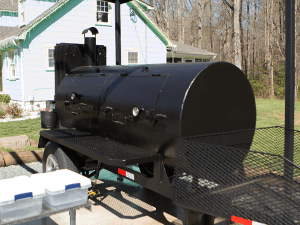The History of Smoked Meat
If you are a meat lover, like many people, then you most likely enjoy trying new recipes. There are many ways to enjoy meat, from the grill to the oven. Perhaps, one of the most popular ways in which to dine is with smoked meat. Smoked meat has a distinct flavor from the smoking process that cannot be duplicated via the oven or grill. But where did it all begin? Who decided to try the smoking process for the very first time? Read on to see how this delicious cooking process first came about.
What is Smoked Meat?

This is the actual smoker used for cooking all of the flavorful smoked meat at Chad’s BBQ.
Smoked meat refers to the process of cooking and preserving by exposing meat to smoke from burning wood or other sources. The process of smoking meat involves two main components: flavoring and preservation.
- Flavoring: Smoking imparts a distinct smoky flavor to the meat, enhancing its taste and aroma. The type of wood used for smoking can greatly influence the flavor profile of the meat. Additionally, some recipes may incorporate herbs, spices, or marinades to further enhance the flavor.
- Preservation: Historically, smoking was used as a method of preserving meat before the advent of refrigeration. The smoke contains compounds, such as phenols and creosote, which help inhibit the growth of bacteria and fungi, thus extending the shelf life of the meat. While modern refrigeration has largely replaced smoking as a primary preservation method, the technique is still widely used for its flavor-enhancing properties.
In the past, smokers would consist of a room made of stone where meat would hang from the ceiling. A fire would be used to provide smoke in the room which would dry out the meat and preserve it for some time. Today, smoked meat is done with a smoker, which can be small or large in size. The smoking process cooks the meat slowly, helping to keep the meat tender and tasty.
How It Differs Around the World
Smoked meats are found in various cultures around the world. Different cultures have their own traditional methods and preferences for smoking meats. For example:
- North America: Native American tribes practiced smoking meats long before European colonization. After European settlers arrived, smoking techniques were further developed and diversified, leading to the creation of popular smoked meats such as smoked ham, bacon, and various types of sausages.
- South America: Indigenous peoples of South America have long used smoking as a method of preserving meats, particularly in regions like the Amazon rainforest. In modern times, smoked meats are still popular in countries like Brazil and Argentina, where techniques such as smoking meats over open flames or using specialized smokehouses are employed.
- Africa: In various African cultures, smoking meat is a common method of preservation and flavor enhancement. Different regions have their own unique techniques and preferences for smoking meats, often using local woods and spices for flavoring.
- Europe: Many European countries have a rich tradition of smoking meat. Countries like Germany, Poland, and Italy are known for their smoked sausages and cured meats like prosciutto. In Scandinavia, smoked fish such as salmon is particularly popular.
- Asia: Smoking meats is also common in Asian cuisines. In countries like China and Vietnam, meats like duck and pork are often smoked and used in various dishes. In Japan, bonito fish is traditionally smoked to make a key ingredient in dashi, a fundamental Japanese soup stock.
Overall, the practice of smoking meats has evolved over time and is now enjoyed worldwide, with each culture adding its own unique flavors and techniques to the process.
But Where Did It Start?
Throughout history, smoking meats has been a fundamental aspect of human culinary practices, evolving from a necessity for preservation to a technique valued for its unique flavor contributions to dishes.
- Prehistoric Times: The practice of smoking meats likely originated with early humans. Smoke from fires was used to dry and flavor meats, making them last longer.
- Ancient Times: Evidence suggests that ancient civilizations such as the Egyptians, Greeks, and Romans practiced smoking meats for preservation and flavor enhancement. They used various methods, including hanging meat over fires and constructing smokehouses.
- Middle Ages (5th to 15th Century): Smoking meats became more widespread during the Middle Ages in Europe. Monasteries played a significant role in refining smoking techniques.
- Age of Exploration (15th to 17th Century): With the exploration of the Americas, European settlers encountered Native American tribes who had long been smoking meats. They adopted and adapted indigenous smoking techniques.
- Industrial Revolution (18th to 19th Century): The Industrial Revolution brought advancements in food preservation technology, including the invention of smoking apparatus such as smokehouses and smoke chambers.
- Modern Era (20th Century to Present): In the 20th century, refrigeration largely replaced smoking as the primary method of food preservation. However, smoking remained popular for its flavor-enhancing properties.
If all of this smoking talk has made you crave some authentic, smoked meat, Chad’s BBQ has you covered. Come on in and check out the many smoked meats on our menu.
